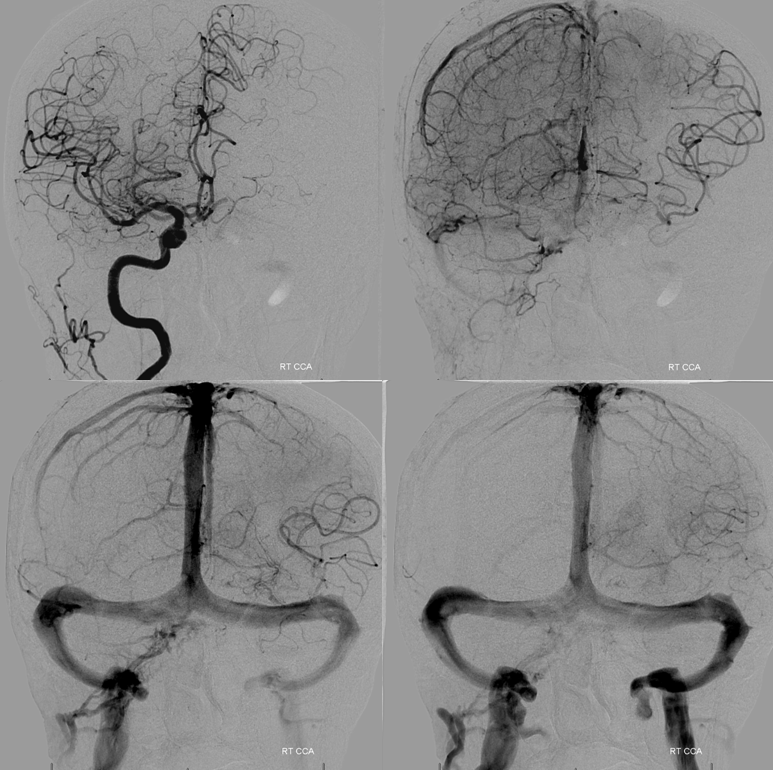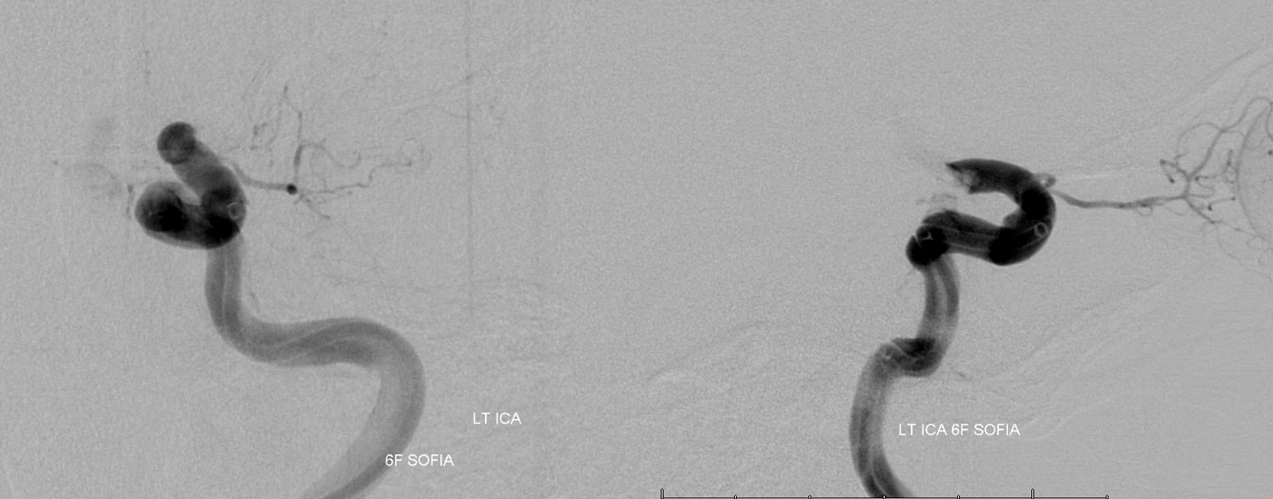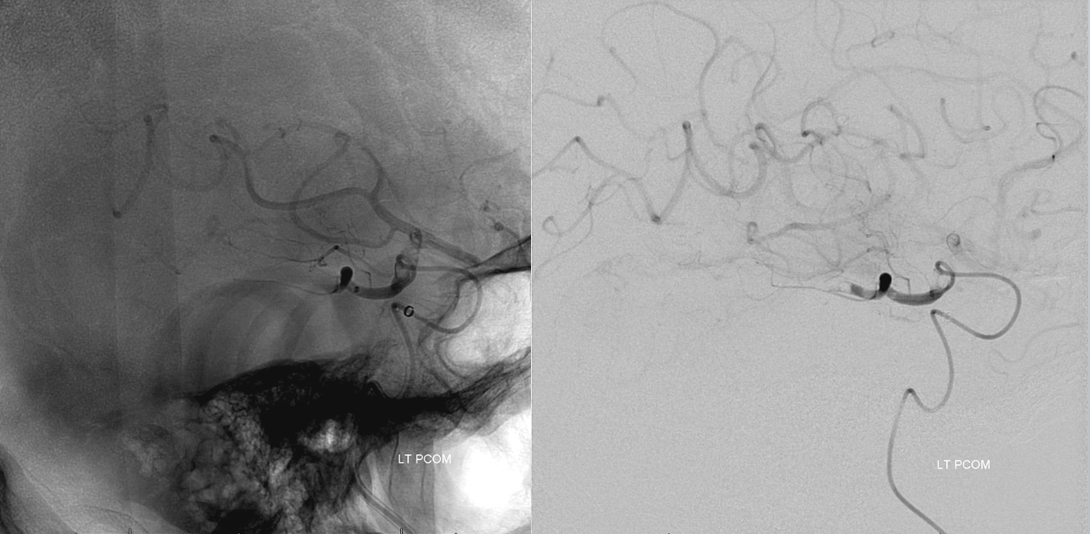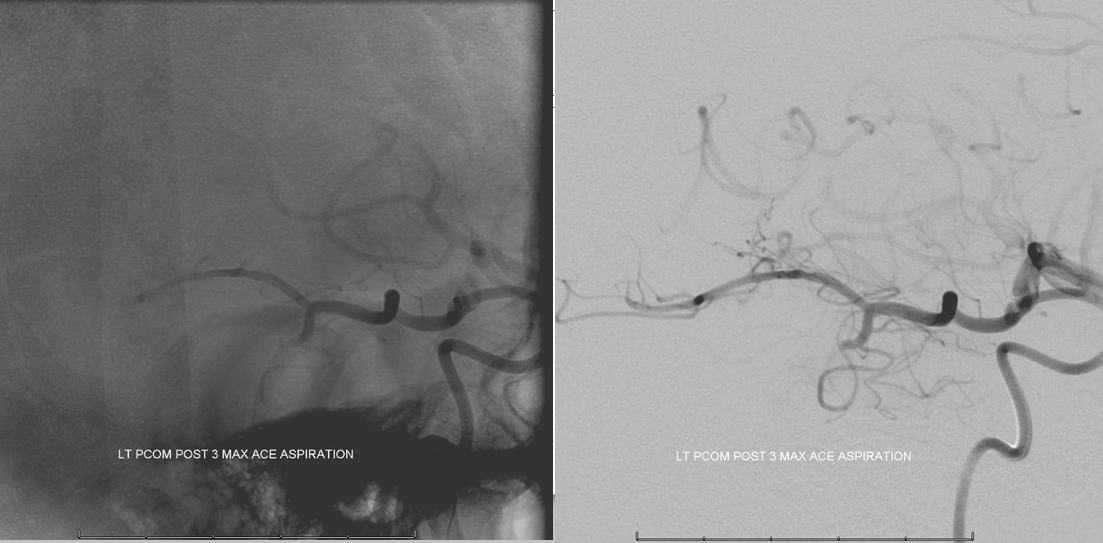This case is dedicated to the statistical concept of Number Needed to Treat
So, neuroangio.org does showcase stroke thrombectomy sometimes. Here is a case which offers something for (almost) everyone — how often do you see that in stroke?
A 90+ year old is brought in within 45 minutes of left MCA syndrome onset — something for the “FAST” crowd.
IV t-PA is given — something for the tPA crowd
Noncontrast head CT is shown below — something for the “ASPECTS” crowd

CT perfusion is done — something for the perfusion crowd
Perfusion shows completed infarction in the occipital and inferior temporal lobes — something for the “anatomical aficionados” crowd — must have a fetal PCOM. Also something for the “collaterals are more important than time” crowd — no collaterals to the PCA territory, which is infarcted despite early arrival — if you believe in CTP (I do)

Angio — vert injection — something for the “must see collaterals” crowd. No collaterals to the bulk of temporal lobe from here.

Right ICA injection — excellent leptomeningeal collaterals to the left MCA convexity, except for inferior temporal and occipital lobes. Something for the “Collateral Index Score” crowd and “collaterals are more important than time” crowd. Also something for the “even nonagenarians can have great collaterals and benefit from thrombectomy” crowd

Common carotid occlusion — something for the “tPA is not much use in LVO” crowd

Post Sofia 6 direct aspiration pass # 1 — something for the direct aspiration crowd. Could a 4×40 Solitaire have opened up everything at once? — something to analyze for the Monday morning quarterbacks crowd.

Continued Sofia aspiration — something for the “bring aspiration catheter into the clot if you want it to work ” crowd.

Post Sofia and Penumbra pump with home-rigged tubing aspiration — something for “Sofia 6F is an awesome catheter for stroke” crowd.

Post-aspiration. Something for possible clot fragmentation with residual PCA occlusion crowd (i dont think its fragmentation though)

Something for “I will keep going until all large vessels have been reopened” crowd. And something for “I don’t stop just because it is technically posterior circulation” crowd. Actually, the clot is distal enough and small enough to have unlikely been a fragmentation. So, something for the aspiration purist crowd.

Something for “I will stick to aspiration” crowd and for the “I still like Penumbra a little bit (its a 3 Max Ace)” crowd

Post PCA 3 Max Ace aspiration. Notice how the Sofia 070 has been purposefully placed into the ostium of the PCOM to help avoid re-embolization into the freshly opened territory. Something for the “Sofia is an awesome catheter” crowd. Also something for the “Simple aspiration may lead to clot fragmentation” crowd.

Finally, we bust out the Solitaire. Something for the Solitaire is an amazingly flexible and effective device you can put into P3 or M3 crowd.

Post Solitaire thrombectomy while aspirating the Sofia 070. Something for the Solumbra (kind of) crowd. Also something for the TICI 3 crowd. Also, in case you haven’t noticed yet — something for the “we do stroke under general anesthesia” crowd.

MRI 2 days later — something for the “Perfusion and Collateral Index Score predict infarct better than noncontrast CT” crowd. Also something for “why did you go for the PCA if you knew it was gone anyway” crowd. Also something for “even nonagenarians can benefit from thrombectomy crowd.

CT scan 1 month later. Something for the “diffusion may not predict final stroke” crowd. Also perhaps something redeeming for the ASPECTS crowd.

Sagittal reconstructions. Something for the “not really, its just a difference in angle, the inferior temporal lobe is really infarcted” crowd.

One month later, this 90+ year old patient is trached and pegged despite encouraging MR and CT results. Certainly something for the nihilistic crowd.

That pretty much covers every crowd, except for the “I like to please everyone” crowd. Because that’s not what we are here for. This is not a case to please anyone — it is a case which shows what “Number Needed To Treat” is all about. The point is that even when we are technically successful in good candidates (those with meaningful salvageable tissue), the number needed to treat is not 1. Not every single case benefits. The NNT is 3 at best — and so we keep going because, ultimately, we help more than we harm.
